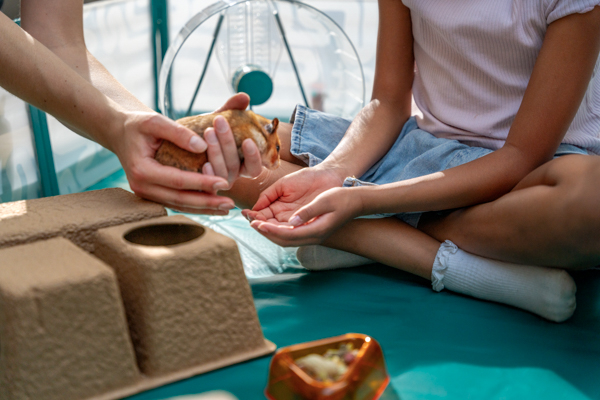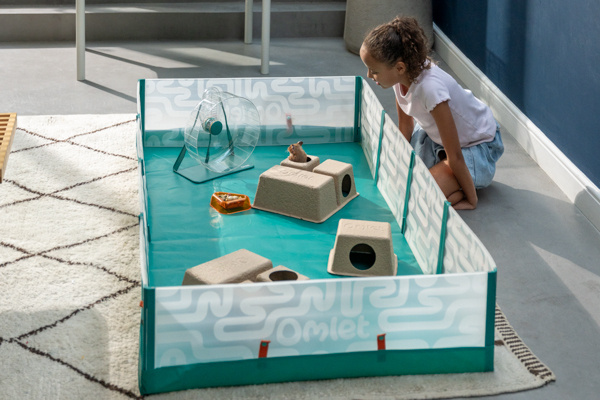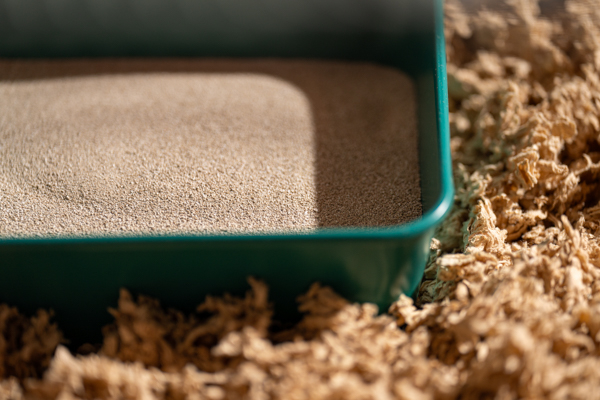In our Hamster FAQ, we’ll answer the most common conundrums and queries that new hamster owners have. Hamsters are fun and relatively easy to care for, but that doesn’t mean you’ll never wonder about how to care for them. From behavioral quandaries, to how to locate a lost hamster, get ready to find answers to the most pressing hamster questions.
Why is my hamster biting me?
This is one of the most common questions that a hamster owner will ask. It’s not because hamster bites occur so often — it’s simply because this action is the most abrupt and startling reaction that hamsters can display.
First and foremost, it’s important to understand hamster behavior, and remember that hamsters always have a reason for biting. Hamsters can bite for a number of reasons, all of which are justified. Those reasons include:
- Pain
- Fear
- Confusion
- Smelling food residue on your hands
Work on hand-training your hamster to get them used to being handled. Never wake your hamster up in order to play or hold them, and always wash your hands before handling them so that they won’t want to sample the last snack you had. If you suspect your hamster is in pain, call your veterinarian right away.

Hamsters are delicate little animals, so hold them very gently
How do I hand-train my hamster?
Hand-training your hamster will help them grow accustomed to being held and handled. This is an important step in owning a hamster — it will build their confidence and the bond that the two of you share. Hand-training is also essential for conducting hamster health checks.
Always give your hamster at least one week on their own before you attempt to handle them. Once your hamster is settled into their new home, you can begin training them to be held. Here are the steps to successfully hand-train your hamster:
- Extend your hand into your hamster’s habitat and let them come to you
- Speak softly to them as they sniff and explore
- Gently grasp your hamster once they’re comfortable in or near your palm
- Hold them for a second or two, then release them gently
Repeat these steps several times during your hamster’s waking hours for a few days. Gradually increase the amount of time that your hamster spends in your hand. Once your hamster is comfortable being held, you can begin moving them to their hamster playpen, or other secure location for playtime.
Remember to hand-train your hamster in a quiet environment to avoid startling them. You may also want to consider wearing gloves if you’re nervous about hand-training your hamster. But when you go slow and take your time, you’ll build a foundation for non-biting hamster handling experiences.
Why is my hamster biting the bars of their enclosure?
Hamsters have front teeth that never stop growing, so they’ll gnaw on whatever they can get their mouth around in an effort to file them down. This is the most common reason that hamsters bite the bars of their enclosures. To correct this potentially painful problem, give your hamster healthier chewing options like applewood chews or Timothy hay.
Hamsters can also gnaw the bars of their enclosure out of boredom. To combat this, make sure your hamster has access to hamster tunnels or other hamster-safe toys and accessories, and take them out of their enclosure daily for playtime.
How much space does my hamster need?
The short answer is: as much space as possible. Like other pets, hamsters thrive when they have access to as large of an area as possible. Many commercial hamster cages are far too small to keep hamsters comfortable — especially a full-sized species like the Syrian hamster.
Giving your pet a large hamster habitat will ensure that they have plenty of space for all of their activities, and help foster their natural behaviors, like burrowing or running. Connecting hamster tubes to your small friend’s enclosure will give them even more room to explore.
Taking your hamster out during playtime will also give them more space for their activities. Use a hamster playpen to let them explore the floor, and to give them more real estate to call their own.
How do I find my hamster if they get lost?
Finding a lost hamster is not an activity that any pet owner wants to participate in, but in some cases it may be necessary. Hamsters are tiny Houdinis that can squeeze or escape through seemingly impossible spaces. It’s always best to have a secure hamster habitat to prevent these midnight escapades, but sometimes hamsters escape during handling sessions or other activities away from their homes.
First, it’s important to remember to stay calm. Your hamster may be enjoying their romp around the room for now, but they’ll soon grow tired and hungry, eager to return to the comfort and safety of their habitat. So, take a deep breath, then follow these steps to start locating your lost hamster:
- Secure any cats, dogs, ferrets, birds, or other pets that may be out in your home
- Put towels or draft-guards in front of doors, and block any other narrow openings
- Get down on your hands and knees to be more on your hamster’s level, taking care to check under each piece of furniture with a flashlight

An Omlet Hamster Playpen allows your pet hamster to safely roam outside their cage
If you can’t find your hamster after thoroughly searching the room, you may need to employ measures that can work during the late-night hours. One of these methods is called the “bucket trap”, and it can be made quickly from supplies you already have in your home. To make your bucket trap:
- Take a container at least 8-10 inches deep so that your hamster can’t easily hop or climb out
- Place the container in a secluded area of the room your hamster was last seen in
- Use a layer of bedding or another soft object to cushion your hamster
- Put a treat like a slice of apple or carrot down into the container
- Build some stairs leading up to the lip of the container — you can use building blocks, wood or cardboard scraps, or books
The idea is that your hamster will be lured in by the treat through their excellent sense of smell, and climb up your homemade stairs and fall into the cup. You can also put a thin layer of tissue paper across the top of the opening to hold pieces of their treat — when your hamster steps onto the tissue paper, they’ll fall through to their soft landing. Check the trap several times a day.
Why is my hamster falling over?
Hamsters age quickly due to their relatively short lifespan. They can suffer from issues with their vestibular (inner ear) system, or from neurological conditions like strokes. These, along with other illnesses or injuries, can cause problems with your hamster’s sense of balance. You may notice your hamster having a head tilt, walking in a tight circle, or being unable to stay upright.
It’s always best to have your hamster evaluated by a veterinarian if you notice them acting unsteady on their feet. Your vet will give you a better idea of the source of the issue, along with any necessary treatment. Conditions like ear infections are easily treated, while neurological issues may just need time to improve.
Do hamsters need a sand bath?
Hamsters usually do a great job keeping themselves clean. But every once in a while they may appreciate the opportunity to take a sand bath. You can leave a sand-bathing container in your hamster’s enclosure for them to use at their leisure, or offer it once or twice a week.
Be sure to get hamster-safe bathing sand — avoid bathing dust (such as those marketed for chinchillas), as it’s too fine and can cause respiratory issues in your hamster.

Whilst hamsters can have negative reactions to water baths, many really enjoy sand baths
Omlet and your hamster
At Omlet, we never stop questioning — it’s how we invent and design pet products that are the perfect solution for pets and owners alike. We encourage you to get closer with your hamster with every question, but that doesn’t mean you have to second guess caring for them. Our hamster habitats and accessories are the answer to countless questions, providing you and your pet with the best setup possible. When you choose Omlet’s hamster products, there’s no question that you’ve given your hamster the best. Now all that’s left is to ask your hamster: what will we do and discover today?
Comments
There are no comments just yet